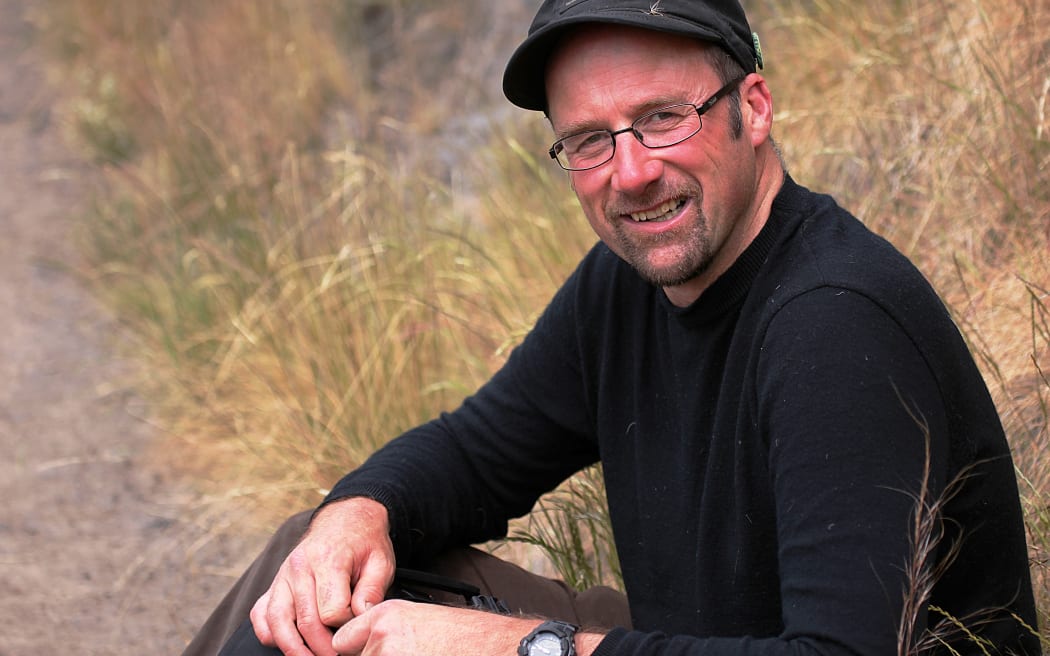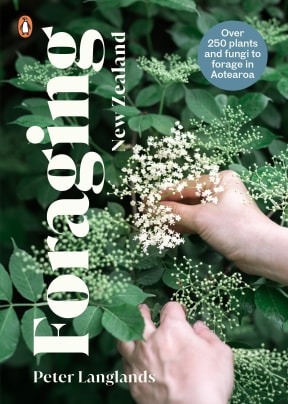
Christchurch foraging expert Peter Langlands Photo: Penguin Books New Zealand
Peter Langlands says his passion for foraging food has turned him into an "accidental botanist".
The Christchurch bird-watcher and conservationist presents a guide to over 250 edible plants and fungi in his new book Foraging New Zealand.
Langlands tells Kathryn Ryan on Nine to Noon that when growing up, family trips into the " spectacular" Canterbury high country left a powerful impression on him.
"My parents loved getting into the outdoors every weekend, just about. It was religious, really."
As a child, he had a taste for foraged gooseberries and apples and a keen eye for birdlife.
"I remember watching wading birds when I was about 10 … 'Cause I had sharp eyes when I was young, [my family would] always get me up to the telescope to try and spot birds for them."
While studying zoology at Canterbury University, Langlands schooled up on taxonomy, species identification and research report writing. Later, as a fly-fishing guide, he learned to experience the outdoors through other people's eyes and capture what he was seeing with a camera. Now, he leads foraging tours around Christchurch.
When you're out gathering wild food, safety should always be a primary concern, Langlands says,
While some plants can be lethal in large doses, it's wild mushrooms that are the "Russian roulette" of foraging.
"They've got deadly toxins in them and there's no going back for a lot of them. It's a one-way process. People are lucky, they may survive with an organ transplant, but it's just the sheer nature of the concentration of the deadly compounds [that can be lethal]."

Photo: Penguin Books New Zealand
Of the thousands of fungi species found in New Zealand, around 120 are safe to eat, he says.
"It's only a real small percentage of species which are edible and you've just got to find an edible species, focus on it and take your time to accurately identify each mushroom as you pick it.
"If you get a whole lot growing together, don't assume they're all the same type. Store them all separately and you've got to be just almost clinical about the whole process.
"It's really rewarding as well because mushrooms are incredibly healthy to eat and they have a really, really nice umami flavour profile. And of course, it's just the fun of going out foraging them - they're pretty spontaneous and they're attractive and they smell nice."
Langlands recommends people start very slowly when foraging any wild food.
"Take your time, do your research. If you're trying a new food for the first time, it does pay to just try a small amount.
"Even some of the recognised edible [fungi] will cause quite severe gastric upsets for some people ... and that's just an individual reaction. It's a journey and it's good to just be mindful often to go slowly."
Foraging New Zealand took four years to come together, he says, with invaluable assistance from Penguin's Harriet Allan.
"If it wasn't for her, I don't think the book would have been completed in the timeframe that it has. A big shout out to Harriet - her enthusiasm for the project was infectious."
Part of the challenge of producing the book, he says, was making a list of 250 native species from his personal database of around 7500.
Langlands' ultimate goal is to get up to 10,000 species of New Zealand flora and fauna recorded on the international database iNaturalist.
"If I can, that's a target that I want to hit. And I think if I geek out and meet with some specialists in New Zealand, I might be able to do that. That will, of course, go beyond edible species but just looking at the biodiversity of what we have in New Zealand."
Getting out into the wild - whatever you're up to - is very good for mental health, Langlands says.
"You've got the mindfulness aspect that just allows you to, you know, forget about your worries and just sort of focus on what you're doing. Just having that sensory engagement is really big.
"I think everything's becoming really hard-edge now. We've gone into the sort of economic thing where it's all about money, it's all about commodities. There's a real dehumanisation process at the moment, which is really concerning me.
"With all this going on, it's good just to hop in the car and you know, go for a walk around a wetlands, go for a walk down the beach or go fly fishing. I've probably got a mind that needs a million and one distractions to stay sane.
"To be honest with everything that's happening in the world at the moment, it [also] gives a really good feeling of self-reliance, of food sovereignty."
Langlands says an increasing number of Canterbury people are employing him to visit their lifestyle blocks and point out possible food sources they can use to sustain themselves if there is a food shortage or emergency.
Broadleaf plantain is a common plant that produces a really nice edible grain, he says, and a lot of other wild greens including dandelion and watercress are highly nutritious and good to eat.
For a time, Langlands worked for the award-winning Queenstown restaurant Amisfield, sourcing from around the Whakatipu basin every day wild food that the chefs could incorporate into dishes.
In New Zealand, chefs haven't been able to make use of our excellent range of edible seaweeds, he says, because of MPI regulations.
"We've got some amazing seaweed here like branching velvet weed. It gets thrown off mussel rafts during harvesting - it could be used. It's really very popular in Europe, in use by some of the top chefs in vegan and vegetarian dishes."
Langlands is concerned that MPI hasn't been able to manage the small-scale, sustainable use of edible resources such as seaweed.
"A lot of government departments are failing to connect with how our resources can be used because the departments themselves are under-resourced to do it.
"Tragically, I think we all lose with the current scenario. That's why I do feel quite strongly about what's happening. We really actually need to invest more in infrastructure, more in science, more in government departments and getting it all back together so that we can use localised management to maximise the use of our wild resources."
Although he doesn't eat exclusively wild food, Langlands says around 60 to 70 percent of the ingredients in the meals he eats are foraged.
"I do buy food but I try to think about it as much as possible. I mean if I had to, I could live on wild foods for a whole year, it wouldn't be a problem. But I do buy probably about 30 to 40 percent of my food, just to experience the full diversity.
"My partner Jackie does a lot of the preparation and cooking with the foods that I get. I've become quite lazy in the kitchen, I get reminded of that. She loves showing on Instagram what she's doing with wild foods and the diversity."

